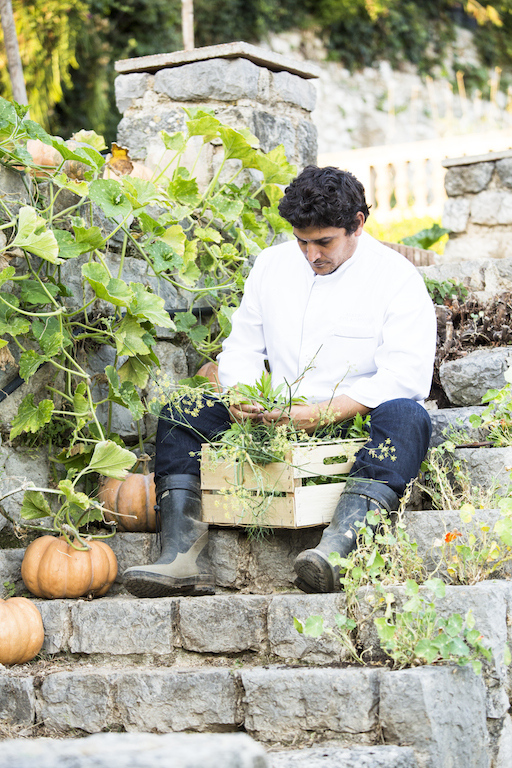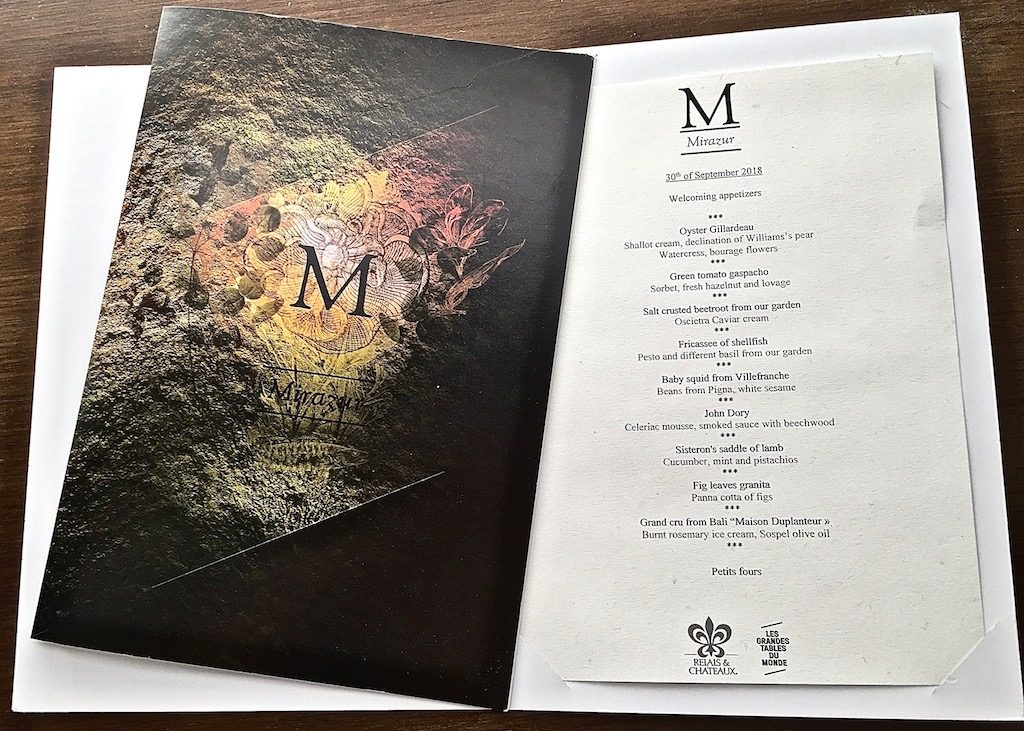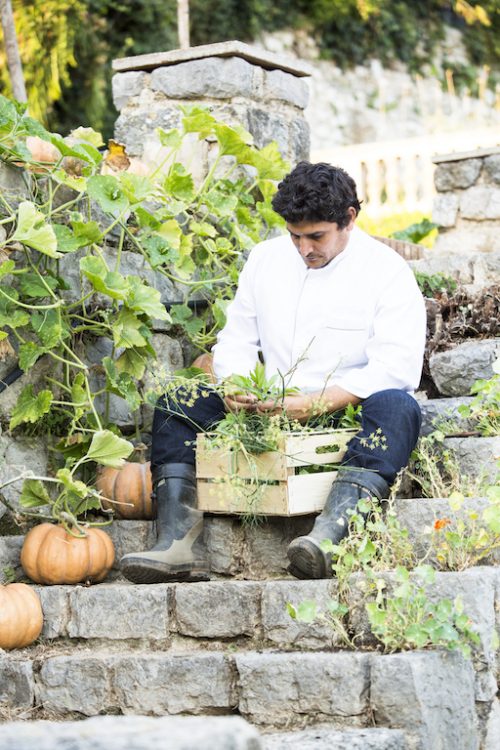BY CHERYL ANDERSON
Chef Mauro Colagreco’s restaurant, Mirazur, has two Michelin stars, receiving the first in 2007 and the second in 2012. “To me, Michelin stars are a recognition of the work we do and a sign of consistency,” says Colagreco.

Chef Mauro Colagreco in his kitchen creating remarkable cuisine (Photo courtesy of Phillipe Fritte).
Mirazur is number three on the S. Pellegrino World’s 50 Best Restaurants list, considered to be the number one restaurant in all of France. As part of the Relais & Châteaux group, Chef Mauro became Grand Chef Relais & Château. He has received the National Order of Merit medal for his contribution to French Culture and was appointed Chevalier des Arts et des Lettres.
It was in 2006 that he opened Mirazur. Of special pride, are his terraced gardens below the restaurant; the herb garden, with it’s estimated 150 or more varieties of herbs and edible flowers and an orchard with 15 lemon trees, including Citron de Menton, and 30 other citrus fruits are at the basement level of Mirazaur. The terraced vegetable garden is a few hundred yards away. Every morning the seasonal organic fruits, vegetables, and little flowers are gathered. The oldest and largest avocado tree in France, estimated to be 200 years old, is also on the property.

Chef Mauro Colagreco in his garden (Photo courtesy of Matteo Carassale).
The chef’s gardens overlook the sea with the Alpes-Maritimes rising in the background. A very favorable microclimate exists in Menton making it the perfect place for growing the vegetables, herbs, pétits fleurs, citrus trees, and, let’s not forget, avocadoes. The old stone wall in the back of the terraced garden holds in the heat, keeping the area warm; it’s even possible to harvest some vegetables in the winter. “I learned that the most important thing is not technique but the quality of the ingredients and their variety. Especially in Menton the seasons are divided, and they are called micro-seasons,” explains Colagreco.

The old stone wall keeps the area warm (Photo courtesy of Matteo Carassale).

A nearby evergreen adds to the beauty of the area (Photo courtesy of Matteo Carassale).
The only place in France where bananas are grown is in Menton. Now I know where those little bananas I see in the markets are from. I never knew that they are a product of Menton and will make a point to try some next year.
Buying local is very important to Chef Mauro. Mirazur is only 30 meters from the Italian border, so the Ventimiglia market in San Remo is a convenient place to shop several times a week, particularly for their gamberonis (langoustines). I’ve been many times, and it is quite amazing—and only 12 minutes by train from Menton. (I do recommend the train as finding a place to park can be very frustrating.)
Trumpet zucchinis are not available in Menton, but they are in Italy. Buying local also includes buying fish from “the last master fisherman in town,” the Citron de Menton, and France has great goat cheeses. Cherries come from Gorbio, the ancien perché village in the hills above Menton.
As Chef Mauro says, “Lemon is king in Menton,” so to highlight its importance to Menton he makes a lemon confit, made from a jam with genuine Citron de Menton, and also incorporates them into a delicious tarte au citron. During the Fête de Citron in Menton, he prepares a citrus menu at Mirazur, naturally including the Citron de Menton. The Citron de Menton is a favorite choice because the thick white peel keeps the lemon from becoming bitter and has less acidity.
As the Argentinian chef puts it, his cuisine is “one sans borders and frontiers, utilizing the best products of both the sea and land.” He says, “I cook from my heart, and the day I lose that emotion, it will be time to move on.” I once had the La Forêt (land) & Homard (sea) menu. I have never forgotten how delicious it was.

A passion for tomatoes (Photo courtesy of Matteo Carassale).
Chef Mauro has a passion for tomatoes with 35-plus varieties in his garden, adding a new variety every year. Tomatoes remind him of being a child, picking sun-ripened tomatoes with his much loved Italian paternal grandmother in Argentina. He fondly remembers the sauce she made from scratch and served with ravioli and dumplings. Chef Mauro extends his creative passion to canvas, as he is also an artist.
His first visit to Mirazur was in the month of November. He was living in Paris where it was cold and rainy and wanted a change. Friends suggested he visit Mirazur. Upon his arrival in Menton, the sky was sunny, people were sitting outside at cafés, and it was by the sea. Mirazur was exactly what he was looking for to open his own business—a restaurant on the Côte d’Azur! He found a space (an Art Deco-inspired building built in the 1950s) and an amenable owner who could see the passion he had for his craft—all that was left to figure out was financing. A deal was struck between them with very low rent in the beginning. The rest, as they say, is history.

View of Menton from Mirazur (Photo courtesy of Mirazur).
Mirazur commands a panoramic view of the Méditerranée, Garavan Bay, and the Côte d’Azur coastline with Menton in the distance. In the evening the village sparkles like the candles on the tables. During the day, the light streaming in brightens the room. Each time I walk up the curving stairway into the dining area, I am transported into a setting that is open and serene, inviting me to have fun and enjoy!

Pink champagne to start. Oui!

A tasty amuse-bouche.

Crusty bread to start is a tradition at Mirazur.
Before the beautifully plated selections from the menu you have chosen or the amuse-bouche arrives, a crusty loaf of bread and small bowls of olive oil for dipping are set on the table, accompanied with a printed copy of an ode about bread by Pablo Neruda, a Mirazur custom that has continued for years. Each person is given a copy that they may take home.
From that point on, the ingredients of each appetizer and course are expertly described. It’s not by accident that the service is professional and friendly. If on the menu you have chosen, there is something on it you are allergic to or simply do not like, but everything else is agreeable, a substitute will gladly be made. When making the reservation, I was asked if anyone in the party had any food allergies and, if so, it would be noted. This query was again made at the table just to be sure.
Mirazur has a children’s menu because Chef Mauro thinks it’s important that the next generation should have a pleasant experience at a good restaurant and exposure to dishes with “complex tastes”; the ravioli are made from his grandmother’s recipe. Infants are also welcome to be a part of it all.
A copy of the menu you chose, listing all of its courses, will have been placed in a folder with the Mirazur image on its cover, which is given to you at the end of the meal. I love the custom. Receiving it during my first visit there was such a pleasant surprise.

My menu will long be remembered.
A quote I particularly like about Chef Mauro’s dishes is this: “Mauro Colagreco brings a living energy to the plate that just simply makes you feel better for having eaten his food.” This rings true for me for it’s exactly how I feel every time I have a meal at Mirazur, fortunate to experience such “living energy.”

Oyster Gillardeau avec fleurs minuscules.

So pretty, so delicious.

Pagre (Légumes et poisson).
Every chef, during their career, takes something away from working with master chefs. Two, among others, taught Chef Mauro valuable lessons. Bernard Loiseau told him to “be yourself” and a great deal about the art of making sauces. Bernard was a sauce expert. Alain Passard introduced him to the wonder (my word not his) of vegetables and “the ability to express himself in his cuisine.”

Oeuf, crème de chou-fleur. A most interesting presentation with feathers. (I wasn’t so sure, but it was amazing!)

Crème aux herbes. Almost too pretty to eat.
This past September I had the opportunity to have another dish created by Mauro Colagreco that brought the land and the sea together, Beetroot with cream and osietre caviar. The 50 World’s Best Restaurants list says it’s “a stand-out dish,” and I couldn’t agree more. That day the large beetroots had been gown in his garden. They’re steamed in a salt crust for up to five hours, then thinly sliced and mounded in the center of the plate, topped with a heavenly cream and osietre caviar. I have to say it was one of the best dishes I have ever tasted. The combination of those three ingredients was sheer genius. Even the beautiful white plate that looked like it could have come from the sea was perfect!

Beetroot from the Mirazur garden, cream, and osietre caviar together was amazing!
My history of dining at Mirazur goes back many years. There have been changes in chefs and a period of time when it was closed. Now that Mauro Colagreco has taken the helm, I feel very fortunate indeed to have a restaurant of such quality in the town I love and have visited for twenty-five years. He and I agree that Menton is “one of the most beautiful places in the world.”
Interestingly, you can visit one of his restaurants at the Nice airport, L’Estivale (meaning the summer). It is located before the security checkpoint, and people from businesses in the area are frequent customers. All the suppliers are handpicked by Chef Mauro and the restaurant’s chef, one of his own former chefs. “We had to come up with a tasty menu, something sophisticated but that was quick to serve,” Golagreco says.
I had the opportunity to ask Chef Colagreco if he would be willing to answer a few questions, and he graciously agreed. What follows are his very thoughtful answers. He is remarkable, passionate, and a chef extraordinaire. I wish you bon appétit if ever you have the chance to dine at Mirazur, Côte d’Azur.
Bonne Vacance!
***
When did your passion for cooking begin? Who was your mentor?
My great inspiration for becoming a cook was my grandmother Amalia—she was the one initiating me into the mysteries of the kitchen. Since then I devoted myself to cookery, body and soul, and I had the pleasure and privilege to learn with some of the greatest chefs in France in the earlier years of my career.
Currently, who are those you most admire in the culinary field?
I admire lots of chefs and friends that are passionate by their work and that reinvent their own world, but I have a special admiration for my friend David Kinch, Chef of Manresa, for his sensibility, techniques, and commitment.
Where did you train as a cook? What was your first job?
After I finished my studies at La Rochelle, I worked with Bernard Loiseau at Restaurant La Côte d’Or for one-and-a-half years.
When did you first become the chef at Mirazur? What drew you to the Cote d’Azur?
I opened Mirazur in 2006. Finding this place was a great surprise and adventure. Initially, I was thinking about opening in the north of Spain, but I received a call from a friend saying he had found an amazing building, and I just went there to take a look. I was amazed and immediately knew it would be my future restaurant.
Before Mirazur, can you tell us about a few restaurants where you have worked?
I trained under Alain Passard, Alain Ducasse, and Guy Martin. After leaving La Côte d’Or, I moved to Paris. I worked with Alain Passard at L’Arpege, and he was a great inspiration for installing the love of vegetables and the ability to express myself in my cuisine. I then moved to Plaza Athénée to work with Alain Ducasse and then at Le Grand Véfour under Guy Martin.
You grow much of the produce used in your dishes. Where is the garden located? Is it year-round?
I have always loved gardens, once you can see the products growing up and it turns into something beautiful and inspiring. So, I have created my own garden by the restaurant, and we have a lot of varieties of vegetables and fruits. Along with the gardener I plan what we grow based on the seasons. I also bring seeds from all my trips around the world in order to have different varieties, colors, and flavors.
A true Menton lemon is difficult to find to buy. Where are the trees located that are available to you for your dishes—or is that a secret?
I am lucky enough to have Menton lemon trees in my aromatic garden at the restaurant. There is also a mentonese that is producing and taking care of this beautiful fruit so it will never disappear but that is a secret!
How did your association with the Menton olive oil company, Huilerie Saint Michel, begin? Was buying locally a consideration?
Buying local and supporting small producers has always been one of my main concerns. Karim Djekhar is a great friend of mine, and we met when I was looking for to produce my own olive oils. We connected because he has the same vision as me when it comes to the quality of products and the respect for nature.
Do you have a hand in choosing the dishes (plates, bowls, etc.) used for your extraordinary culinary creations? In my experience as a diner at Mirazur, they all seem perfectly suited.
I love to choose all the chinaware at the restaurant; we are a small family restaurant, so my wife and I are very involved with these Mirazur “touches.” I love to search for new ways of serving food, so during my trips around the world I usually look for chinaware or sometimes I have ideas when I see something that inspires me.
How do the ideas come to you when conjuring a new dish?
Inspiration comes from all sides: my garden, my trips, my family, new products and experiences, eating, etc. And what I then do is to try to work to simplify my dishes as much as possible. My vision is to bring the best out of exceptional products, and that is what I have in mind when putting ideas together in a new dish.
The idea of giving a print-out of what a diner had for their meal is brilliant. Was that something you have always done?
When I decided to stop having à la carte dishes and doing surprise menus, I thought it would be a good idea to let the client leave with some concrete souvenir of the dinner. Of course, the strength of their experience in Mirazur is important, but I like to think that leaving with the concrete menu will help to keep the images and memory of what they have eaten—the whole experience at Mirazur, with them.
***
Mirazur
30 ave Aristide Briand
Menton
+33 4 92 41 86 86







